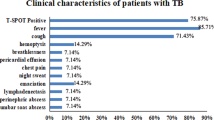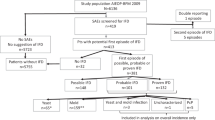Abstract
Earlier invasive fungal infections (IFI) put recipients of hematopoietic SCT (HSCT) at a high risk of IFI-related mortality. We retrospectively assessed the feasibility of HSCT for patients with a history of IFI and the efficacy of secondary prophylaxis. From January 2001 to December 2007, 49 patients with a history of IFI underwent HSCT and most of them received broad-spectrum antifungal agents as secondary prophylaxis. After a median follow-up of 355 days (15–967), nine patients experienced failure of IFI prophylaxis, including three cases of IFI-related death, leading to a 2-year cumulative incidence of 18.4 and 6.1%, respectively. Four risk factors for the failure of prophylaxis were found, namely time interval from the diagnosis of IFI to transplantation, residual diseases before transplantation, infection with CMV and use of corticosteroid for the treatment of GVHD. A similar outcome can be achieved in recipients of Auto- and Auto-HSCT. Despite a higher risk of post-transplant progression, residual features of IFI did not affect the overall outcome of HSCT. In conclusion, a history of IFI and residual features are not contraindications to HSCT and secondary prophylaxis by broad-spectrum antifungal agents can protect patients from relapse or progression of an earlier infection.
This is a preview of subscription content, access via your institution
Access options
Subscribe to this journal
Receive 12 print issues and online access
$259.00 per year
only $21.58 per issue
Buy this article
- Purchase on Springer Link
- Instant access to full article PDF
Prices may be subject to local taxes which are calculated during checkout



Similar content being viewed by others
References
Post MJ, Lass-Floerl C, Gastl G, Nachbaur D . Invasive fungal infections in allogeneic and autologous stem cell transplant recipients: a single-center study of 166 transplanted patients. Transpl Infect Dis 2007; 9: 189–195.
Upton A, Kirby KA, Carpenter P, Boeckh M, Marr KA . Invasive aspergillosis following hematopoietic cell transplantation: outcomes and prognostic factors associated with mortality. Clin Infect Dis 2007; 44: 531–540.
Pagano L, Caira M, Nosari A, Van Lint MT, Candoni A, Offidani M et al. Fungal infections in recipients of hematopoietic stem cell transplants: results of the SEIFEM B-2004 study—Sorveglianza Epidemiologica Infezioni Fungine Nelle Emopatie Maligne. Clin Infect Dis 2007; 45: 1161–1170.
Fukuda T, Boeckh M, Guthrie KA, Mattson DK, Owens S, Wald A et al. Invasive aspergillosis before allogeneic hematopoietic stem cell transplantation: 10-year experience at a single transplant center. Biol Blood Marrow Transplant 2004; 10: 494–503.
Avivi I, Oren I, Haddad N, Rowe J, Dann E . Stem cell transplantation post invasive fungal infection is a feasible task. Am J Hematol 2004; 75: 6–11.
Offner F, Cordonnier C, Ljungman P, Prentice HG, Engelhard D, De Bacquer D et al. Impact of previous aspergillosis on the outcome of bone marrow transplantation. Clin Infect Dis 1998; 26: 1098–1103.
de Fabritiis P, Spagnoli A, Di Bartolomeo P, Locasciulli A, Cudillo L, Milone G et al. Efficacy of caspofungin as secondary prophylaxis in patients undergoing allogeneic stem cell transplantation with prior pulmonary and/or systemic fungal infection. Bone Marrow Transplant 2007; 40: 245–249.
Allinson K, Kolve H, Gumbinger HG, Vormoor HJ, Ehlert K, Groll AH . Secondary antifungal prophylaxis in paediatric allogeneic haematopoietic stem cell recipients. J Antimicrob Chemother 2008; 61: 734–742.
Krüger WH, Rüssmann B, de Wit M, Kröger N, Renges H, Sobottka I et al. Haematopoietic cell transplantation of patients with a history of deep or invasive fungal infection during prophylaxis with liposomal amphotericin B. Acta Haematol 2005; 113: 104–108.
Hill BT, Kondapalli L, Artz A, Smith S, Rich E, Godley L et al. Successful allogeneic transplantation of patients with suspected prior invasive mold infection. Leuk Lymphoma 2007; 48: 1799–1805.
Cordonnier C, Maury S, Pautas C, Bastié JN, Chehata S, Castaigne S et al. Secondary antifungal prophylaxis with voriconazole to adhere to scheduled treatment in leukemic patients and stem cell transplant recipients. Bone Marrow Transplant 2004; 33: 943–948.
Cheikh J, Faucher C, Fürst S, Duran S, Berger P, Vey N et al. High-dose weekly liposomal amphotericin B antifungal prophylaxis following reduced-intensity conditioning allogeneic stem cell transplantation. Bone Marrow Transplantation 2007; 39: 301–306.
Ascioglu S, Rex JH, de Pauw B, Bennett JE, Bille J, Crokaert F et al. Defining opportunistic invasive fungal infections in immunocompromised patients with cancer and hematopoietic stem cell transplants: an international consensus. Clin Infect Dis 2002; 34: 7–14.
De Pauw B, Walsh TJ, Donnelly JP, Stevens DA, Edwards JE, Calandra T et al. Revised definitions of invasive fungal disease from the European Organization for Research and Treatment of Cancer/Invasive Fungal Infections Cooperative Group and the National Institute of Allergy and Infectious Diseases Mycoses Study Group (EORTC/MSG) Consensus Group. Clin Infect Dis 2008; 46: 1813–1821.
Borlenghi E, Cattaneo C, Capucci MA, Pan A, Quaresmini G, Franco F et al. Usefulness of the MSG/IFICG/EORTC diagnostic criteria of invasive pulmonary aspergillosis in the clinical management of patients with acute leukaemia developing pulmonary infiltrates. Ann Hematol 2007; 86: 205–210.
Martino R, Parody R, Fukuda T, Maertens J, Theunissen K, Ho A et al. Impact of the intensity of the pretransplantation conditioning regimen in patients with prior invasive aspergillosis undergoing allogeneic hematopoietic stem cell transplantation: a retrospective survey of the Infectious Diseases Working Party of the European Group for Blood and Marrow Transplantation. Blood 2006; 108: 2928–2936.
Therasse P, Arbuck SG, Eisenhauer EA, Wanders J, Kaplan RS, Rubinstein L et al. New guidelines to evaluate the response to treatment in solid tumors. European Organization for Research and Treatment of Cancer, National Cancer Institute of the United States, National Cancer Institute of Canada. J Natl Cancer Inst 2000; 92: 205–216.
Klein JP, Rizzo JD, Zhang MJ, Keiding N . Statistical methods for the analysis and presentation of the results of bone marrow transplants. Part I: unadjusted analysis. Bone Marrow Transplant 2001; 28: 909–915. Table 2: Risk factors of failure of prophylaxis 5.
Klein JP, Rizzo JD, Zhang MJ, Keiding N . Statistical methods for the analysis and presentation of the results of bone marrow transplants. Part 2: regression modeling. Bone Marrow Transplant 2001; 28: 1001–1011.
Maertens J . Evaluating prophylaxis of invasive fungal infections in patients with haematologic malignancies. Eur J Haematol 2007; 78: 275–282.
Robenshtok E, Gafter-Gvili A, Goldberg E, Weinberger M, Yeshurun M, Leibovici L et al. Antifungal prophylaxis in cancer patients after chemotherapy or hematopoietic stem-cell transplantation: systematic review and meta-analysis. J Clin Oncol 2007; 25: 5471–5489.
Thursky K, Byrnes G, Grigg A, Szer J, Slavin M . Risk factors for post-engraftment invasive aspergillosis in allogeneic stem cell transplantation. Bone Marrow Transplant 2004; 34: 115–121.
Cornely OA, Böhme A, Reichert D, Reuter S, Maschmeyer G, Maertens J et al. Risk factors for breakthrough invasive fungal infection during secondary prophylaxis. J Antimicrob Chemother 2008; 61: 939–946.
Marr KA, Carter RA, Boeckh M, Martin P, Corey L . Invasive aspergillosis in allogeneic stem cell transplant recipients: changes in epidemiology and risk factors. Blood 2002; 100: 4358–4366.
Author information
Authors and Affiliations
Corresponding author
Rights and permissions
About this article
Cite this article
Zhang, P., Song, A., Wang, Z. et al. Hematopoietic SCT in patients with a history of invasive fungal infection. Bone Marrow Transplant 43, 533–537 (2009). https://doi.org/10.1038/bmt.2008.356
Received:
Revised:
Accepted:
Published:
Issue Date:
DOI: https://doi.org/10.1038/bmt.2008.356
Keywords
This article is cited by
-
Outcome of allogeneic SCT in patients with pre-transplant invasive fungal infection
Bone Marrow Transplantation (2013)
-
The impact of prior invasive mold infections in leukemia patients who undergo allo-SCT in the era of triazole-based secondary prophylaxis
Bone Marrow Transplantation (2013)
-
Voriconazole for both successful treatment of disseminated Trichosporon asahii infection and subsequent cord blood transplantation in an infant with acute myelogenous leukemia
Bone Marrow Transplantation (2011)
-
Secondary Antifungal Prophylaxis in Hematopoietic Stem Cell Transplantation (HSCT)/Acute Leukemia Patients
Current Infectious Disease Reports (2011)
-
Risk factors for fungal pulmonary infections in hematopoietic stem cell transplantation recipients: the role of iron overload
Bone Marrow Transplantation (2010)



